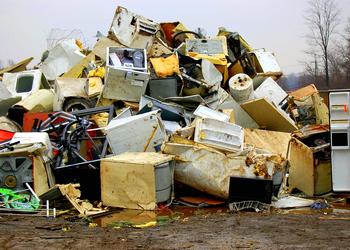
TOKYO, Japan, April 20, 2015 (ENS) – The United States and China produce the most e-waste overall – 32 percent of the world’s total. But the top per capita e-waste producers are the wealthy nations of northern and western Europe, the top five being Norway, Switzerland, Iceland, Denmark, and the United Kingdom.
In 2014, people worldwide discarded all but a fraction of an estimated 41.8 million metric tonnes of electrical and electronic products – mostly end-of-life kitchen, laundry and bathroom equipment like microwave ovens, washing machines and dishwashers.

And the volume of e-waste is expected to rise by 21 percent to 50 million metric tonnes (Mt) in 2018.
The new figures were released Sunday in the Global E-Waste Monitor 2014, a report compiled by the United Nations University, the UN’s think tank.
UN Under-Secretary-General David Malone, rector of UNU, said, “Worldwide, e-waste constitutes a valuable ‘urban mine’ – a large potential reservoir of recyclable materials. At the same time, the hazardous content of e-waste constitutes a ‘toxic mine’ that must be managed with extreme care.”
The report offers in unprecedented detail a wealth of insights into the location and composition of the world’s fast-growing e-waste problem.
Just seven percent of e-waste last year was made up of mobile phones, calculators, personal computers, printers, and small information technology equipment.
Almost 60 percent was a mix of large and small equipment used in homes and businesses:
• 12.8 Mt of small equipment such as: vacuum cleaners, microwaves, toasters, electric shavers and video cameras
• 11.8 Mt of large equipment such as: washing machines, dryers, dishwashers, electric stoves and solar panels
• 7.0 Mt of cooling and freezing equipment
• 6.3 Mt of monitor screens
• 3.0 Mt of small electronics such as: mobile phones, pocket calculators, personal computers and printers,
• 1.0 Mt of lamps
“This report, based on empirical data, provides an unprecedented level of detail and a more accurate overview of the magnitude of the e-waste problem in world different regions than has ever been reported previously,” said co-author Kees Baldé of United Nations University Institute for the Advanced Study of Sustainability in Bonn, Germany.
Picture the 41.8 million metric tonnes of last year’s e-waste as 1.15 million 40-ton 18-wheel trucks forming a line of trucks 23,000 kilometers (14,290 miles) long, or the distance from New York to Tokyo and back.

Less than one-sixth of last year’s e-waste was diverted from landfills to recycling and reuse, the report states.
The e-waste generated in 2014 contained an estimated 300 metric tonnes of gold, equal to 11 percent of the world’s total gold production in 2013.
In addition, last year’s e-waste contained 16,500 kilotons of iron and 1,900 kilotons of copper as well as silver, aluminum, palladium, plastic and other resources with a combined estimated value of US$52 billion (48 billion Euro).
Toxins in that e-waste include 2.2 metric tonnes of lead glass, more than six times the weight of the Empire State Building and one-third of a ton of batteries, as well as mercury, cadmium, chromium and 4,400 metric tonnes of ozone-depleting substances.
Health problems associated with such toxins include impaired mental development, cancer, and damage to livers and kidneys.
The escalating global e-waste problem is driven by the rising sales and shortening life cycles of electrical and electronic equipment, according to the Global E-Waste Monitor 2014.
“The monitor provides a baseline for national policymakers, producers and the recycling industry, to plan take-back systems,” said Malone.
“It can also facilitate cooperation around controlling illegal trade, supporting necessary technology development and transfer, and assisting international organizations, governments and research institutes in their efforts as they develop appropriate countermeasures,” Malone said.
“This will eventually lead to improved resource efficiency while reducing the environmental and health impacts of e-waste,” he said.
The report found that in 2014 some four billion people were covered by national e-waste legislation – though not all laws cover the full range of e-waste and are not all enforced.
Copyright Environment News Service (ENS) 2015. All rights reserved.
© 2015, Environment News Service. All rights reserved. Content may be quoted only with proper attribution and a direct link to the original article. Full reproduction is prohibited.
